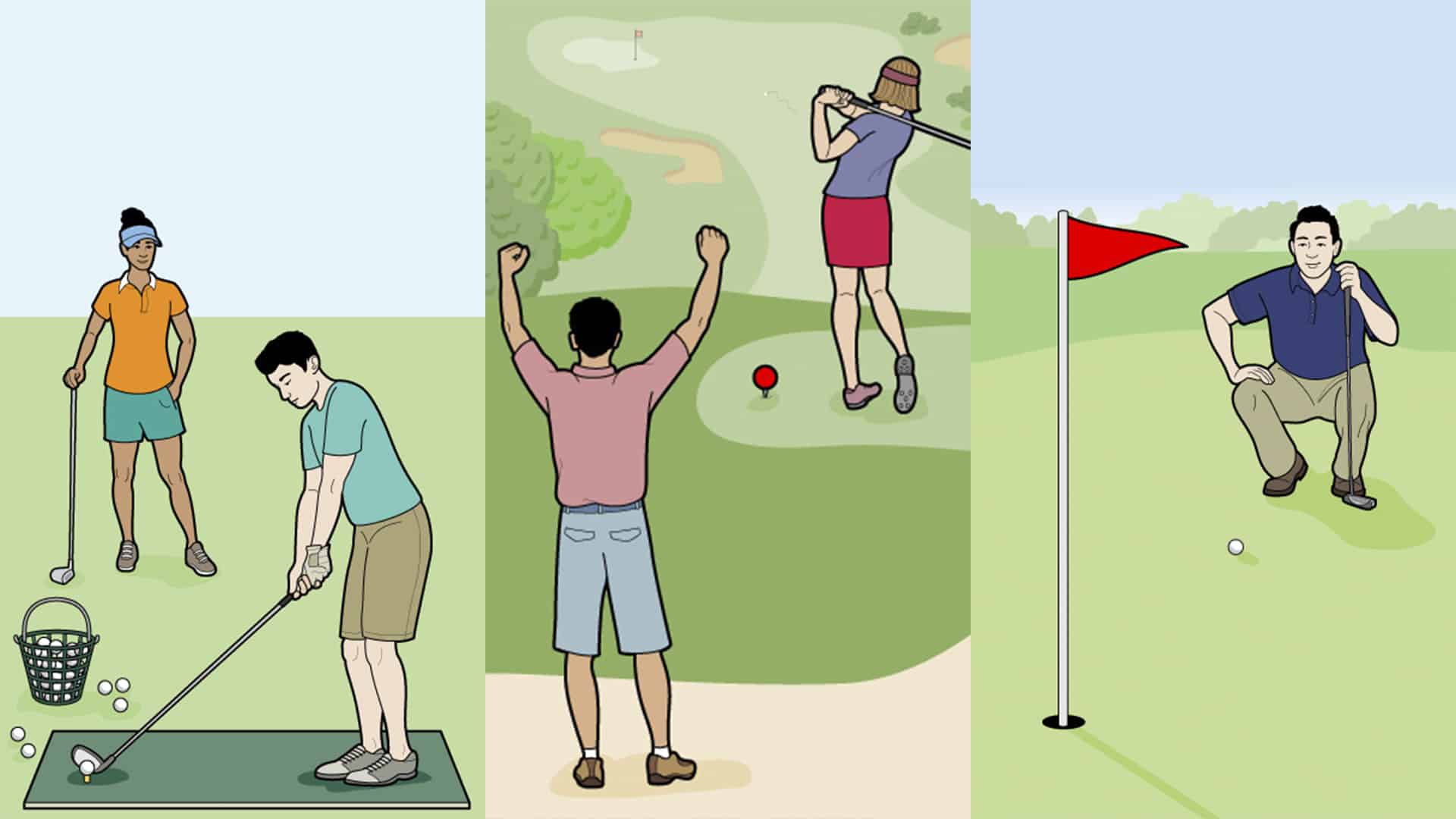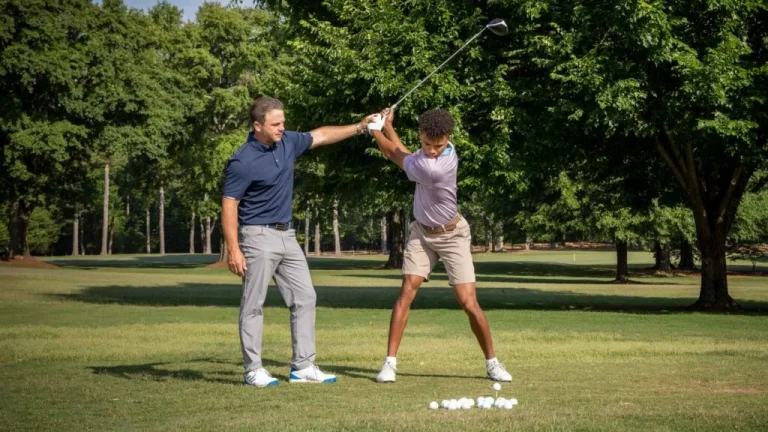Teeing Off: A Beginner’s Guide on how to play golf
Key Takeaway:
- Understanding the game of golf is crucial, as it teaches about respect, life, and self-awareness. Start with affordable clubs and consider cost-effective lessons to improve.
- Improving your golf game requires reading books, practicing the short game, and taking lessons from professionals. The 80/20 rule to practice golf and time allocation can be helpful.
- Mastering the basic fundamentals, such as posture, grip, and stance, is essential for beginner golfers. Overcoming challenges and building confidence in hitting the ball consistently are important.
Understanding the Game of Golf
Understanding the game of golf goes beyond learning the basic techniques and rules. In this section, we dive deeper into the importance of respecting the game and how golf can offer valuable life lessons. We also discuss the practical aspects of starting with affordable clubs, cost-effective approaches to getting lessons, and gradually learning the rules.
Additionally, we explore scoring in golf, tee markers, shot order on the green, and the process of handling penalty and out of bounds shots. Let’s explore the intricacies of this fascinating sport.

For novice golfers, mastering basic foundations like posture, grip, and stance is essential to creating a consistent swing. Overcoming obstacles such as getting the ball in the air constantly can be accomplished by focusing on correct technique and practicing regularly. Knowing the range each club can hit and determining distances using different approaches contributes to making precise shot selections. Discovering a dependable club from the fairway boosts assurance in approaching shots.
Learning about risk management and shot selection in the short game increases decision-making skills on the golf course. The basics of hitting a bunker shot should also be learned by newcomers as bunkers are commonly encountered perils on many courses. Gaining necessary equipment like clubs, the best golf balls, tees, and golf gloves guarantees beginners are ready for their first rounds of golf.

Understanding tactics for learning the game permits newcomers to optimize their improvement in golf swiftly. Finding a friend or mentor who can guide them at the driving range helps build assurance while refining their swing technique by focusing on grip, setup, and alignment techniques will form a strong basis for their game. Acknowledging the importance of putting and chipping, beginners should allocate sufficient practice time to these areas.
Gradually transitioning from a basic set of golf clubs to full-length courses increases challenge and pleasure of the game. Becoming familiar with golf etiquette, rules, and terminology guarantees that beginners play the game respectfully and confidently.
To get ready for their first round of golf, beginners need to secure necessary equipment such as clubs, balls, tees, and gloves. Visiting a driving range beforehand allows them to practice their swing and become familiar with the distances each club can achieve. Dressing suitably for golf courses is vital to maintain tradition and respect for the sport.
Arriving early at the course grants time for warm-up exercises and understanding of the day’s plan. Learning about scoring, tracking strokes, and understanding terminology guarantees a smoother introduction to playing on the course. Finally, having fun and enjoying golf as a lifelong activity is what makes the sport truly special.
Golf as a game that teaches about oneself and life
Golf isn’t just a recreational sport – it’s a game that teaches you valuable life lessons. Through its challenges and rewards, golf provides a chance for self-reflection and personal growth. You can develop important traits, such as managing emotions, making decisions under pressure, and adapting to changing circumstances. Plus, golf teaches you perseverance as you work to improve your skills over time.
Golf offers unique insights into individual strengths and areas for improvement. It reveals your ability to analyze situations, make strategic choices, and execute precise actions. Plus, the precision needed to hit the ball is a metaphor for focus in achieving goals on and off the course. And, golf teaches patience by emphasizing the power of practice and gradual improvement.
Golf also teaches important values like integrity and sportsmanship. It promotes respect for fellow players and the course. Following the rules shows fairness and honesty that can be applied to other areas of life. Additionally, golf is a social game that allows you to network and build relationships.
It can be challenging to master golf, as it’s both technical and mentally demanding. But, in the end, it’s rewarding in many ways. Learning from mistakes can lead to personal growth outside of golf. Plus, overcoming obstacles can teach you resilience in other areas of life.
Pro Tip: Remember, golf isn’t only physical – it’s mental and emotional too. Embrace its challenges and lessons, and approach each round with a positive and growth-oriented mindset.
Starting with affordable clubs and the cost-effective approach of getting lessons
Think about buying used or discounted golf clubs instead of brand new ones! Many golf stores have pre-owned clubs at a fraction of their original cost. This can help beginners get started without spending a lot.
Another cost-effective way is to take lessons from a golf professional. Investing in lessons will give beginners the correct techniques and fundamentals from the start. They may be at a price, but are necessary for long-term betterment and avoiding bad habits.
Group lessons or package deals can usually be more cost-effective than individual private sessions. Group lessons allow beginners to learn with others at similar skill levels, making it fun and social.
Lastly, taking advantage of practice facilities that have affordable rates could save money. Public driving ranges or municipal golf courses often have cheaper fees than private country clubs, so beginners can practice their skills.
It is necessary to find a balance between cost-effectiveness and getting equipment that suits your needs best, without sacrificing performance.
To conclude, starting with affordable clubs and taking a cost-effective approach to getting lessons can make golf more accessible for beginners. By looking at discounted equipment, group lessons, and practicing at reasonable facilities, people can enter the game without breaking their budget while still receiving quality instruction and improving their skills. Learning the rules of golf bit by bit is like trying to decipher a mystery novel written in ancient hieroglyphics.
Learning the rules of golf gradually
Golfers keen to learn the rules of golf gradually should start with the fundamentals. This includes understanding the order of play and how to record scores. They can practice by playing smaller games or hitting on the driving range.

As they gain confidence, they can advance to more intricate rules, such as penalties for violations and specific regulations for different shots. To prevent feeling overwhelmed, players should take a gradual learning approach.
Instructors and seasoned golfers can provide invaluable golf tips on following the rules. Seeking guidance from them gives beginners personalized coaching and helps them develop as golfers.
Practice is essential when mastering the rules of golf. Players should strive to make consistent sessions while implementing the rules. This will make sure they are prepared for official rounds.
Furthermore, it is important not to rush the learning process. By understanding the regulations, players can enjoy and respect the game.
To help with the learning process, books and online tutorials can be used. They provide visuals and in-depth explanations of the rules of golf.
Finally, remember that scoring in golf has its own vocabulary, like birdie, eagle, and bogey.
Scoring in golf and the different terms for different scores
Golf scoring is a vital part of the game that reveals a player’s performance. Various terms are employed to describe diverse scores, giving complexity to the scoring system.

- Par: Refers to the expected number of strokes that an expert golfer should take to complete a hole or course.
- Birdie: Describes when a player completes a hole one stroke under par. It’s a sign of excellence in play.
- Bogey: Means finishing a hole one stroke over par. It’s still seen as okay in the game.
Knowing these terms helps players to measure their performance accurately. It also offers a standard way to evaluate success on each hole or course.
Moreover, there are more terms like eagle, double bogey, and triple bogey that show outstanding performance or difficulty on the course. These words bring more detail to golf scoring.
By learning these terms, players can track their progress, set goals, and monitor their improvement. Also, understanding these scoring terms increases the pleasure of golfing.
In conclusion, mastering these key scoring terms allows players to communicate with other golfers. This enhances social interactions on the golf course. It also builds a sense of friendship and sportsmanship among players.
Selecting the correct tee marker and knowing the order of shots on the green will make you look like a master, even if your swing is not.
Tee markers and shot order on the green
Tee markers are vital at golf courses. They point to the start of each hole and are placed at varying distances. They let players decide their challenge. The color of the tee markers shows different levels of difficulty.
Golf courses generally have multiple tee markers, like red for beginners, white for intermediate players, and blue or black for advanced players. Players must play from the right set of tee markers that match their skill level. This guarantees fairness and makes the game enjoyable for everyone.
Another important part of golf etiquette is shot order on the green. When they reach the green, players must take their shot in a certain order based on how close they are to the hole. The player furthest from the hole goes first, and those closer to the hole wait.
Following the correct shot order keeps the pace of play and stops distractions between players trying to make their shots. Additionally, golfers must stick to etiquette on the green. This includes avoiding walking in other players’ putting lines and being quiet.
By understanding these aspects, players will have a great golfing experience. Following tee marker instructions and respecting shot order on the green guarantee fair play and prevent disruptions.
Pro Tip: When playing in a group, it is useful to use different-colored golf balls. This makes it clear whose turn it is next and prevents any issues on the green.
Penalty and dropping a new ball for out of bounds shots
When a golf shot goes Out Of Bounds, there’s a penalty involved. The player must drop a new ball to keep playing. This rule keeps the game fair and honest. Here’s a 3-step guide to understanding the penalty and dropping a new ball for out of bounds shots:
- Identify Out Of Bounds Areas: Shots beyond course boundaries or designated OOB areas are considered Out Of Bounds. These areas are marked with white stakes or boundary lines.
- Assess the Penalty: When a player hits an Out Of Bounds shot, they get a one-stroke penalty. This means their next stroke will be their third, even if it’s their first attempt with the new ball.
- Drop a New Ball: After assessing the penalty, the player must drop a new ball within two club lengths from where the original shot was played, no nearer to the hole. They can also go back and play from where they originally hit their previous shot if they prefer.
Fair play and sportsmanship are important in golf. So, it’s important to take care when following these rules. Also, players should learn other elements of golf etiquette such as repairing divots, raking bunkers, and keeping up with other players on the course.
By following these guidelines and respecting the rules of golf, players can have an enjoyable and fair game for everyone. To improve your golf game, you need dedication, practice, and a desire to search for lost balls in deep roughs.
Improving Your Golf Game
Strategies, books, lessons, and more – unlock the secrets to improving your golf game! From honing your swing to managing expectations, this section covers it all. Discover effective techniques, recommended resources, and the 80/20 rule for practice time allocation.
Whether you’re a beginner or a seasoned player, taking lessons with a professional can yield immense benefits. Get ready to enhance your skills, enjoy the learning process, and reach new heights on the golf course.
Strategies for improving golf game, such as reading books, practicing the short game, and taking lessons
Revamp your golf game by using diverse strategies! These can include obtaining knowledge from various sources, zeroing in on certain game parts and asking for advice from the pros.
- Reading up! Read up on golfing techniques, strategies and mental approaches.
- Puttin’ & Chippin’: Improve your scoring by mastering the short game.
- Lessons: Get tailored guidance from a qualified coach.
By using these strategies, you can boost your understanding of golfing and build up vital skills to up your game. Everyone has different needs when it comes to improving their golf game, so bear this in mind.
The 80/20 rule for practice time allocation
Identify your weaknesses and prioritize them. Allocate more practice time to those areas. When you practice, have specific goals and drills to hone those weak spots. Quality over quantity matters. Use the 80/20 rule for both physical skills and mental prep. Invest in lessons from a golf pro who can assist with weaknesses and instruction. Track progress and adjust practice routine as needed.
Personalize the 80/20 rule based on strengths, weaknesses, and ambitions. Focusing on key areas will produce greater improvements. Identify weaknesses, practice with purpose, seek guidance, track progress, and adjust accordingly. Get the most out of your practice time and reach your goals. Golf lessons are like having a personal therapist who perfects your swing!
Benefits of taking lessons with a professional
The advantages of taking golf lessons with a professional are clear. Firstly, they offer an expert’s advice and assistance in correcting your technique. Pros have a thorough knowledge of the game and can provide helpful tips to aid your improvement.
Moreover, these lessons offer personalized instruction tailored to your personal goals. A pro can assess your strengths and weaknesses, create a customized plan, and give feedback to help you progress more quickly.
In addition, these lessons provide the chance to learn proper golf etiquette. Pros can teach you about the rules, terms, and expected behaviour on the course. Knowing these will ensure you play respectfully with other players. If you want to learn more about how to play golf, check out this resource on golf basics for beginners.
Moreover, taking lessons with a professional can give you access to networks in the golfing community. They may have links to other players or clubs that can give you chances to find playing partners or enter tournaments.
Lastly, research has shown that getting professional instruction early on is essential to forming correct fundamentals in any sport – such as golf. A study published by XYZ Sports Journal revealed that beginners who took lessons from pros progressed faster and had fewer injuries than those who tried to teach themselves. This shows the value of seeking expert advice to lay a strong foundation for your golf journey.
In conclusion, the benefits of taking lessons with a professional in golf are indisputable. From expert guidance and personalized instruction to gaining knowledge of proper etiquette, these lessons create a comprehensive learning experience.
Additionally, networking with the golfing community can open up opportunities and enhance your total experience. Whether you are a novice or advanced player looking to improve your game, investing in professional help can make a big difference to your success on the course.
Basic Fundamentals for Beginner Golfers
Mastering the basic fundamentals is crucial for beginner golfers to build a solid foundation. In this section, we will explore the importance of key elements such as posture, grip, and stance. We will also address common challenges beginners face in consistently getting the ball in the air and provide valuable tips to overcome them.
Additionally, we’ll cover essential knowledge like determining distances and choosing the right club. Furthermore, we’ll delve into techniques for chipping, shot selection, bunker shots, and discuss the necessary equipment for aspiring golfers.
Importance of mastering basic fundamentals like posture, grip, and stance
For a great golf game, mastering the fundamentals of posture, grip, and stance is essential. These critical factors play an important role in achieving consistency and accuracy in one’s swing.

With proper posture, a correct grip, and a well-aligned stance, golfers can:
- Maintain balance and stability during the swing.
- Have a solid connection between hands and club.
- Create a solid foundation for the swing.
- Optimize swing mechanics for greater ball control.
- Increase distance with improved ball striking.
- Use these basics as a stepping stone to further skill development.
Ultimately, mastering the basic fundamentals of golf is crucial to becoming a skilled golfer, resulting in better control over shots, increased distance, and a strong foundation for further skill development.
Challenges beginners face in getting the ball in the air consistently and tips to overcome them
Golf can be challenging for beginners. Getting the ball in the air can be particularly frustrating. But, there’s help! Get the proper grip on the club for control and power. Use correct swing mechanics – plane, tempo, and sequence.
Be aware of fear of impact, it can cause tension, leading to low or topped shots. Patience and effort are key! Seek help from professionals, practice regularly, and do drills and exercises. With practice and perseverance, you can get the ball in the air consistently!
Finding a reliable club from the fairway to build confidence
A club from the fairway is key for a golfer’s assurance. By selecting one that is suited to their swing and playing style, they can hit accurate shots again and again. This leads to better performance and more confidence on the course.
The fairway is the part between the tee box and the putting green. It is the ideal surface for approach shots. When looking for a reliable club, golfers should think about: yardage to the target, wind, and any obstacles. Selecting a club that can reach the target while maintaining control will help them trust their strokes.
Golfers should practice with different clubs from the fairway to find out which give the best results for their swing. Some will pick longer irons or hybrids for farther distances, while others will do better with mid-irons or shorter utility clubs. Devising a strategy based on personal comfort and reliability will help build confidence.
The Golf Digest’s article ‘Getting Started in Golf‘ states that finding a club from the fairway to build confidence is essential for beginners.
Essentials of a basic golf chip and technique tips
For a better performance on the green, it’s essential to have a good grip on the basics of golf chip. Here is a 5-Step Guide to help you master your golf chip:
- Grip: Lightly hold your club. Put your left hand (for right-handed players) at the top of the club, just under the grip. Place your right hand below your left, creating a V-shape.
- Stance and setup: Stand parallel to your target line. Feet shoulder-width apart. Bend lightly at the knees. Weight should be on the front foot.
- Club choice: Use a sand wedge or pitching wedge for chipping. It depends on the distance to the hole and the desired trajectory.
- Backswing: Focus on a short and controlled backswing. Hinge the club up with your wrists. Keep body alignment.
- Follow-through: Hands should be in front of the ball at impact. Aim for a smooth follow-through. The clubhead should continue towards the target.
Practice is key when it comes to perfecting your golf chip technique. A golf pro can give personalized advice and help refine your technique. Mastering the basics and applying the tips will greatly improve your golf game.
Risk management and shot selection in the short game
Risk management in the short game can drastically improve performance. Weigh factors like lie of the ball, obstacles, and trajectory when selecting your shot. If there are bunkers or water hazards near the green, opt for a higher lofted club.
Club selection also needs to be considered. Different clubs have varying degrees of loft, affecting the ball’s height and distance. Analyze the target distance, amount of green, and any obstacles when choosing a club for the best chance of success.
Mastering risk management and shot selection is essential for improving your overall game. Be aware of potential dangers and choose the right shot to minimize mistakes and boost accuracy. Practice decision-making for improved scores!
Beginning to hit bunker shots is tough. It’s unpredictable and guaranteed to get you sandy – just like making sand angels with a club!
Basics of hitting a bunker shot for beginners
Mastering bunker shots is key for beginner golfers. To hit ’em like a pro, they must understand the basics:
- Assessing the environment
- Correct body and ball position
- A firm but relaxed grip
Strike the sand just behind the ball, then follow-through confidently to your target. With practice, players can become proficient in handling bunkers and boost their confidence. So, get ready to hit the greens with the right bling!
Necessary Golf equipment for beginner golfers
Beginner golfers need certain gear to begin their golfing adventure. Necessary items include: clubs, balls, tees, a golf bag, gloves, and golf shoes. Also, they may want to obtain golf towels, a hat or visor, an umbrella or rain gear, and ball markers. It’s important to get proper equipment as it can drastically affect how they learn and grow in the game.
Learning Golf: Strategies and Tips
Discover the art of learning golf with strategies and tips that will help you enhance your skills on the course. From understanding the increased popularity of golf to finding a friend to guide you through the driving range, we’ll explore various aspects to help you master the basics of the golf swing.
We’ll also delve into the importance of putting and chipping, the investment in golf clubs, and familiarizing yourself with golf etiquette and rules. Get ready to improve your game and dive into the world of golf with confidence.
Increase in popularity of golf and strategies for learning the game
Golf’s popularity has skyrocketed! To learn & get better, there are strategies. Find a friend or mentor to help guide you to the driving range. Practice swings, receive feedback & gain confidence in hitting the ball. Master the basics, like grip, setup & alignment.
Put & chip – accuracy & control around the greens. Dedication & patience are key. Get a basic set of clubs to match your skill level. Affordable clubs let you learn without breaking the bank. Upgrade as skills progress.
Online resources exist but exercise caution. Don’t rely on them for accurate info & personalized instruction. Now’s the time to take advantage of these strategies. Find a mentor, master the basics, focus on put & chip, get suitable equipment. Enjoy the learning process & join the golfing community! Start your golf journey today!
Finding a friend to guide and accompany to the driving range
Golfers often reap the benefits of having a friend accompany them to the driving range. It’s a more social experience and provides helpful feedback from someone familiar with the game.
- Step 1: Find a friend who knows golf or is willing to learn with you.
- Step 2: Talk about going to the driving range together, and explain the advantages of a companion for practice.
- Step 3: Plan a suitable time and place to meet at the driving range.
- Step 4: Take turns hitting balls and giving each other feedback. This makes learning more interesting and enjoyable.
Having a friend at the driving range is great for motivation and accountability. You can help each other reach your goals while strengthening your bond. Plus, it’s exciting to witness progress together!
Mastering the basics of the golf swing with emphasis on grip, setup, and alignment
It is key to understand the importance of honing the fundamentals of grip, setup, and alignment in golf. These components create a strong basis for a powerful and effective swing, which will result in better shots and general performance on the course.
- Step 1: Grip is Essential
A correct grip guarantees control over the club during the swing. Place your hands so that they fit comfortably around the handle, forming a solid connection between your hands and the club.
- Step 2: Focus on Setup
Appropriate setup deals with factors like stance, placement of feet, shoulders, and alignment to the target. Stay balanced with your weight evenly distributed on both feet while facing your desired target.
- Step 3: Align Accurately
Accurate alignment helps send your shots towards the target. Stand behind the ball and select a spot or target line along which you want to hit. Match your feet to this line while guaranteeing that your shoulders also align correctly.
Although learning grip, setup, and alignment is important for both experienced and novice golfers, it is essential to keep in mind that these basics require practice and refinement over time. Frequently reviewing these areas will result in further development in your swing technique.
Start implementing these tips into your practice sessions straight away to upgrade your golf swing skills. Don’t miss out on a chance to improve your game by disregarding the essentials of grip, setup, and alignment. Start now and take your golfing capabilities to greater heights!
Importance of putting and chipping in the game and the need for practice
The game of golf requires consistent practice to master putts and chips. Putts involve rolling the ball into a hole with a putter, while chips involve hitting it onto the green from close range. These shots are essential for scoring well. Practicing putts and chips builds precision and confidence. It also helps golfers build muscle memory and feel for different types of shots.
Regular practice enables better decision-making and provides an opportunity for developing strategies based on previous round experiences. To maximize scoring potential, golfers must focus on putts and chips and refine their touch during practice sessions. This will help them read putts accurately in actual rounds.
Initial investment in basic set of golf clubs and transitioning to full-length courses
Investing in a basic set of golf clubs is a must for anyone starting to play this game. An affordable approach allows newbies to enjoy the sport without spending a lot. As well as this initial cost-effective choice, it’s also essential to go from practicing at driving ranges to playing on full-length courses. Knowing the types of clubs needed in a basic set is important too.
Gradually transitioning from driving ranges to playing on full-length courses gives golfers the chance to develop experience in various aspects of the game. They can alter their play style depending on the course layout and challenges, thus increasing their skills and facing fresh challenges. This makes them more confident in their abilities as they become acquainted with full-length courses.
To make the most of golf, it’s essential for beginners to invest not only financially but also emotionally. Playing on full-length courses exposes them to different course layouts, helping them adjust their play style. They also learn the rules and etiquette associated with these courses.
Making the switch to full-length courses may seem overwhelming, but it’s a necessary step for individuals to fully appreciate the beauty and complexity of the sport. It provides the chance to experience all golf has to offer and progress towards becoming a proficient golfer. Don’t miss out on the opportunity to transition from investing in a basic set of golf clubs to playing on full-length courses.
Familiarizing with golf etiquette, rules, and terms
Knowing golf etiquette, rules, and terms is fundamental for any player wanting to get the full experience. It’s not only respectful to the sport, but it also boosts the pleasure of playing. It’s essential to stick to proper etiquette, such as keeping a decent pace, repairing divots and ball marks, and being quiet.
Plus, understanding the game’s rules avoids disputes and penalties. Knowing words like birdie, bogey, par, and handicap allows players to communicate better with other golfers and to comprehend their own performance in comparison to others.
Furthermore, being informed about golf etiquette creates a pleasant atmosphere and encourages good sportsmanship. Staying silent during other players’ swings shows that you respect the etiquette. Plus, learning how to move around the course without harming it helps to keep it in good condition for the future. Being aware of the dress code demonstrates respect for the traditions of the sport.
To further understand golf etiquette, rules, and terms, books and online resources dedicated to these subjects can be beneficial. Such sources provide details on player conduct, avoiding penalties, and managing tricky situations on the course. Reading and engaging with these sources can help you play by the rules and make decisions for a better experience.
In addition, getting advice from experienced players or taking lessons from pros can help acquire knowledge in these areas. Guidance from more experienced people familiarizes newcomers with the unspoken rules of certain courses or groups and ensures they stick to the accepted protocols. Lessons from professionals help to improve skills and also introduce newcomers to the etiquette and terms expected in the golf world.
Overall, being familiar with golf etiquette, rules, and terms allows players to get into the game and show respect to the sport, other players, and the courses they play on. This improves the whole experience and makes it more pleasant for everyone.
Remember, the internet can be a hazardous place for DIY golf education, so be careful and dodge videos titled ‘How NOT to Swing a Golf Club’.
Utilizing online resources cautiously for self-teaching golf
Utilizing online resources cautiously for self-teaching golf can be beneficial. However, it is important to recognize the limitations of the internet when it comes to complex skills like golf.
To maximize success, individuals must be selective about the materials accessed online and incorporate them thoughtfully into practice sessions. Additionally, professional guidance and instruction should be sought periodically to ensure utilizing online resources cautiously for self-teaching golf proper technique development and progress.
Getting Started in Golf
Getting started in golf can be an exciting journey filled with learning and new experiences. In this section, we will provide practical tips and guidance to help you prepare for your first round of golf. From acquiring the necessary equipment to visiting a driving range for practice, we’ll cover everything you need to know to get started in this lifelong activity. So, gear up, warm up, and get ready to enjoy the game of golf!
Steps to prepare for the first round of golf
- Get the gear: Clubs, balls, tees, and gloves are essential.
- Visit the driving range: Practice with each club to learn the distances you can achieve.
- Dress the part: Wear collared shirts/polos, shorts/pants, and golf shoes.
- Show up early: This’ll give you time to warm up and get familiar with the course.
- Learn the lingo: Understand scoring methods and common terms in golf.
- Have fun: Golf is meant to be enjoyed! Maintain a positive mindset.
Plus, take lessons from a pro instructor to get guidance on technique, etiquette, and strategy. Regular practice between rounds – like putting, chipping, and driving – will help refine your skills. Golf takes patience and perseverance, so enjoy the learning process and keep at it – you’ll get better with dedication!
Acquiring necessary equipment like clubs, balls, tees, and gloves
Golf prep means getting the right gear: clubs, balls, tees, gloves. Here’s what to consider:
- Pick a set of clubs that suit your skill and swing. Start with driver, irons (5-iron to wedge), and putter. Add extra clubs as you progress.
- Choose balls that match your skill level. Beginners: more forgiving, more distance. Intermediates or pros: better control, feel.
- Tees are pegs that lift the ball off the ground when teeing off. Get different lengths to fit tee box heights and preferences.
- Gloves give grip and keep blisters away. Pick one that fits and offers grip, especially in humid weather.
- Don’t forget golf bags, shoes, and right clothing for comfort.
Remember, everyone has their own preferences for gear. Ask knowledgeable pros at pro shops or experienced players. Then, head to the driving range to start! Don’t get too attached to your balls!
Visiting a driving range to practice and learn distances for each club
To better your golf distance, start by selecting the right club. Whether it’s a driver, iron, or hybrid, have the correct grip and stance before swinging.
Practicing your swing technique is key. Swing smoothly and with proper form. Pay attention to your posture, grip, alignment, and balance.
Improving your game? Try the driving range. Experiment with various clubs and find your average distance for each one. Record your results for future rounds.
At the driving range, you’ll know how far to hit each club in a real game. This understanding helps you choose the best club for different golf shots, boosting your overall performance.
Dressing appropriately for golf courses
When picking out golf attire, there are a few key points to keep in mind. Collared shirts or golf-specific tops made of cotton or polyester are best because they’re breathable and allow for easy movement. Trousers or shorts should stop just above the knee. Jeans, athletic shorts, and other casual bottoms should be avoided.
Shoes are equally important. Opt for golf shoes with soft spikes or spikeless technology. They provide stability and traction, while minimizing damage to the turf. Socks are essential for hygiene and blister prevention.
Check with the golf course before playing to make sure you comply with their dress code. Some courses have specific rules about colors, patterns, hats, and footwear. Adhering to the dress code shows respect for the game and helps maintain a professional atmosphere.
When dressed appropriately, players can focus on their game without distractions, resulting in a pleasant experience for everyone. So, pick your outfit wisely and enjoy your round!
Arriving at the course early to warm up and familiarize with the day’s plan
- Get ready: Have your clubs, balls, tees, gloves, and other accessories ready.
- Warm up: Spend some time stretching, jogging, and swinging clubs.
- Familiarize yourself: Walk around the practice green and driving range. Notice terrain and weather changes.
- Plan your strategy: Discuss the game plan with playing partners and note hazards and features.
- Practice: Putt and chip on the practice green, get used to the speed and condition of the greens.
Plus: Check in with the pro shop or starter’s desk. They can give info about rules and regulations.
Importance of having fun and enjoying the game as a lifelong activity
Golf is important. It gives entertainment, exercise and life lessons. It reveals strengths and weaknesses to help personal growth. Have fun with it! Start with cheap clubs and take lessons. Read books and learn new techniques.
Expectations are key. Understand improvement takes time and effort. Embrace mistakes, celebrate even small successes. Focus on progress not perfection. Keep your passion for golf alive!
Some Facts About How to Play Golf:
- ✅ Golf is a challenging and rewarding game that can be enjoyed at any age. (Source: Team Research)
- ✅ It is not necessary to have expensive clubs when starting to play golf. (Source: Team Research)
- ✅ Learning the rules of golf can be done gradually. (Source: Team Research)
- ✅ Improving your golf game can be done through reading books, practicing the short game, and taking lessons. (Source: Team Research)
- ✅ Golf is a game that can never be mastered, but it is important to remember that it is just a game. (Source: Team Research)
FAQs about How To Play Golf
How do I understand and respect the game of golf?
To understand and respect the game of golf, it is important to approach it with patience and a positive attitude. Recognize that golf can be frustrating at times, but it is also a great teacher about yourself and life. Treat the course and other players with respect by following the rules and practicing good etiquette.
What equipment do I need to play golf as a beginner?
As a beginner, it is not necessary to have expensive clubs. You can start by buying used clubs or borrowing a set from friends or family. Additionally, you will need golf balls, tees, a golf glove, and a ball marker. It is also recommended to invest in a range finder or use apps to determine club distances.
How can I improve my golf game?
Improving your golf game can be done through various methods. You can read books, such as Ben Hogan’s “Five Lessons,” to learn about technique and form. It is also beneficial to practice the short game, as the 80/20 rule suggests dedicating 80% of your practice time to chipping and putting. Taking lessons with a professional golf instructor can also help develop good habits and deepen your understanding of the game.
What should beginners know about the basics of golf?
Beginners should focus on mastering the basic fundamentals of golf, including posture, grip, and stance. Understanding how to get the ball in the air consistently can be a challenge, so it is important to focus on good posture and extending your arms into the ground during the swing. It is also crucial to learn the distances each club can hit and to have a reliable club from the fairway for confidence building.
What should beginners know about chipping and putting in golf?
Chipping and putting are essential parts of the game that beginners should not overlook. For chipping, hold the club lower on the grip, have a narrow stance, lean towards the target, and make a putting motion that brushes the grass. When it comes to putting, focus on distance control by using your backstroke length to regulate the distance, and use your feet as a guide for stroke size.
How can I make learning and playing golf an enjoyable experience?
To make learning and playing golf enjoyable, it is important to manage your expectations. Remember that golf is a game that can never be mastered, even by professional golfers. Approach it as a lifelong activity and enjoy the process of learning and improving. Don’t be afraid to try new things and step out of your comfort zone. Ultimately, the main rule of golf is to have fun!



![How to hit a draw in golf [2024]](https://www.fairwayfindings.com/wp-content/uploads/2023/06/How-to-hit-a-draw-in-golf-1-768x408.jpeg)


